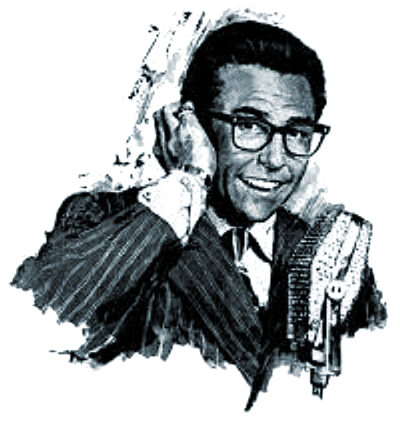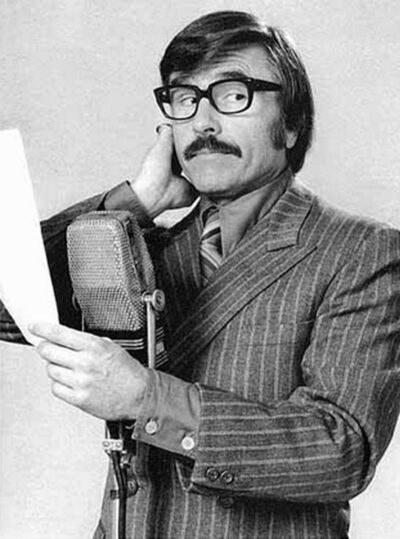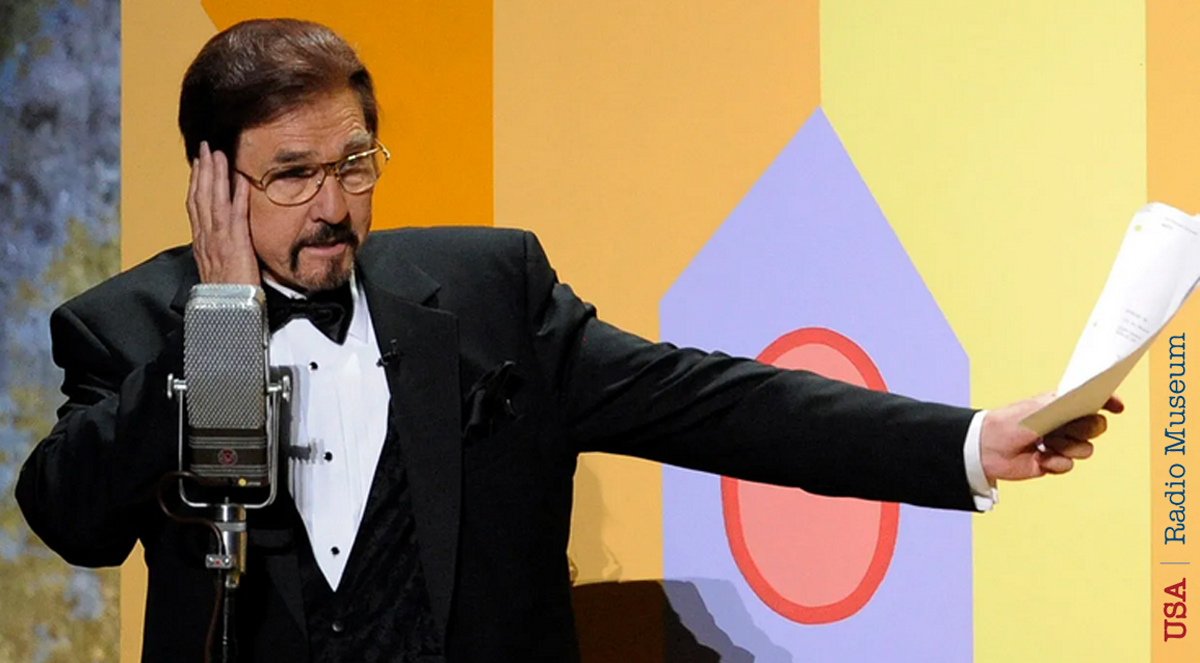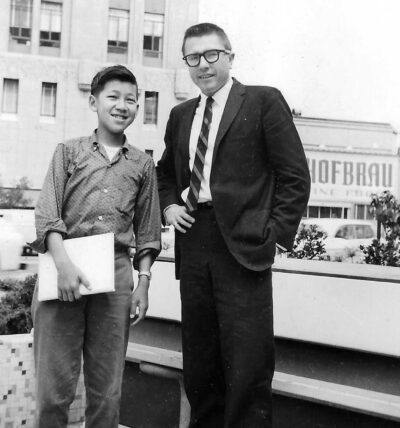Introduction: A Voice That Became a Broadcasting Signature In the golden age of radio and the kaleidoscopic swirl of 1960s television, few voices w
Introduction: A Voice That Became a Broadcasting Signature
 In the golden age of radio and the kaleidoscopic swirl of 1960s television, few voices were as instantly recognizable—or as joyfully absurd—as Gary Owens’. His polished baritone could sell a product, spoof a genre, or summon a superhero, all with the same effortless charm. Whether cupping his ear in mock-seriousness or narrating a cartoon with deadpan flair, Owens turned the act of speaking into a performance art.
In the golden age of radio and the kaleidoscopic swirl of 1960s television, few voices were as instantly recognizable—or as joyfully absurd—as Gary Owens’. His polished baritone could sell a product, spoof a genre, or summon a superhero, all with the same effortless charm. Whether cupping his ear in mock-seriousness or narrating a cartoon with deadpan flair, Owens turned the act of speaking into a performance art.
He wasn’t just a broadcaster—he was a sonic stylist, blending elegance with eccentricity, sincerity with satire. His voice became a signature, not just for the shows he anchored, but for an entire era of entertainment. From the smooth afternoon airwaves of KMPC Hollywood, where he reigned for two decades, to the psychedelic punchlines of Rowan & Martin’s Laugh-In, Owens was always in on the joke—and often the one delivering it.
His versatility was unmatched. In animation, he gave life to characters like Space Ghost, Roger Ramjet, and Powdered Toast Man, anchoring the ridiculous in the real. In syndication, he became the velvet voice of Music of Your Life, guiding listeners through decades of beloved melodies with warmth and wit. And in every medium, he brought a sense of joy, timing, and polish that made him not just a voice actor or announcer, but a cultural icon.
Gary Owens’ legacy is one of longevity, adaptability, and pure entertainment. He bridged generations, genres, and formats, always with a wink and a perfectly timed pause. His voice didn’t just fill the airwaves—it shaped them. And in doing so, he became a living echo of America’s broadcast imagination. — USA RADIO MUSEUM
_____________________
Early Life and Education: From Mitchell to the Microphone
Gary Bernard Altman—known to the world as Gary Owens—was born on May 10, 1934, in the quiet town of Mitchell, South Dakota, a place best known for its Corn Palace and prairie charm. His parents, Venetta Clark and Bernard Joseph Altman, were civic-minded pillars of the community: Venetta served as a county auditor and educator, while Bernard was a county treasurer and sheriff. From this modest Midwestern backdrop, Gary’s fascination with sound and storytelling began to take root.
As a child, Gary was drawn to the radio like a moth to a glowing dial. He would spend hours listening to announcers, mimicking their voices, and inventing characters of his own. His early exposure to the rhythms of radio—news bulletins, dramatic serials, and musical interludes—sparked a lifelong love affair with the medium. By the time he was a teenager, that passion had become a calling.
At just 18 years old, Gary began his professional broadcasting career at KORN/Mitchell, reading the news with a voice that already carried the polish and poise of a seasoned announcer. His delivery was crisp, his timing impeccable, and his wit unmistakable. Within a short time, he was promoted to news director, a rare achievement for someone so young. But Gary’s ambitions stretched far beyond the borders of South Dakota.
In the 1950s, Owens embarked on a whirlwind journey across the American radio landscape, becoming a kind of sonic troubadour. He brought his unique blend of offbeat humor, musical curation, and announcer gravitas to stations in Omaha, Denver, Dallas, St. Louis, San Antonio, New Orleans, Houston, and Oakland. Each city added a new layer to his style—Southern charm, Western swagger, urban cool—and each station gave him room to experiment, refine, and evolve.
Though Owens never pursued a formal college degree, his education came through immersion: in studios, sound booths, and control rooms. He studied the art of timing, the science of modulation, and the psychology of audience connection. He learned how to make a microphone smile, how to turn a pause into a punchline, and how to wrap absurdity in elegance.
By the end of the decade, Gary Owens had become more than a disc jockey—he was a radio personality, a performer whose voice carried not just information, but identity. His early years were a masterclass in reinvention, resilience, and the pursuit of sonic excellence.
KMPC and the Rise of a Radio Icon
When Gary Owens arrived in Los Angeles in 1961, he was already a seasoned traveler of the American airwaves. But it was in the City of Angels that his voice would become legend. Owens first took the morning mic at KFWB, one of L.A.’s top Top 40 stations, where his blend of smooth delivery and surreal humor quickly set him apart. But it was his move to KMPC/Los Angeles in 1962 that cemented his status as a radio icon.
KMPC was a powerhouse of Middle of the Road (MOR) programming, catering to an adult audience with a mix of standards, soft pop, and personality-driven shows. Owens took over the afternoon drive slot, and for the next 20 years, he ruled the airwaves with a style that was uniquely his own: part announcer, part comedian, part cultural curator.
His show was a masterclass in controlled chaos. Owens would deliver mock-serious news bulletins about imaginary towns, conduct interviews with fictional guests, and spin records with a wink. He coined phrases like “Beautiful downtown Burbank,” which became so popular that Johnny Carson adopted it for The Tonight Show. Owens’ delivery was always polished, but his content was delightfully absurd—he was the straight man in a universe of nonsense.
Listeners tuned in not just for the music, but for the experience. Owens created a world within his broadcast—a place where satire, nostalgia, and elegance coexisted. He was known for his “ear-cupping” pose, a visual gag that became iconic during his television appearances but originated in his radio persona. It was a nod to old-school announcers, delivered with tongue firmly in cheek.
Beyond KMPC, Owens’ voice reached national audiences through syndication. He became a nightly fixture on over 200 stations via the Music of Your Life network, which celebrated the timeless tunes of the 1940s through 1960s. His shows—Soundtrack of the Sixties, Superfun, and Gary Owens’ Weekend Spectacular—were syndicated gems, blending music, trivia, and Owens’ signature wit.
Owens’ KMPC era wasn’t just a chapter—it was a golden age. He helped define what personality radio could be: smart, funny, and deeply engaging. His influence extended to other broadcasters, comedians, and voice actors who saw in Owens a model of how to be both professional and playful.
Laugh-In and Television Stardom
By the late 1960s, Gary Owens had already conquered Los Angeles radio. But in 1968, his surreal sensibilities and golden voice found a new stage: television. Owens was cast as the announcer for NBC’s Rowan & Martin’s Laugh-In, a groundbreaking sketch comedy show that exploded onto the cultural scene with psychedelic visuals, rapid-fire gags, and a cast of rising stars including Goldie Hawn, Lily Tomlin, Arte Johnson, and Jo Anne Worley.
 Owens didn’t just announce the show—he became part of its DNA. Standing in front of a swirling backdrop, hand cupped over one ear in mock-serious announcer pose, he delivered absurd introductions with deadpan precision. His voice was rich, authoritative, and utterly ridiculous—a perfect contrast to the show’s anarchic energy.
Owens didn’t just announce the show—he became part of its DNA. Standing in front of a swirling backdrop, hand cupped over one ear in mock-serious announcer pose, he delivered absurd introductions with deadpan precision. His voice was rich, authoritative, and utterly ridiculous—a perfect contrast to the show’s anarchic energy.
He’d intone lines like:
The phrase “beautiful downtown Burbank,” originally coined during his KMPC days, became a national catchphrase thanks to Laugh-In. Owens’ delivery was so iconic that John Wayne once appeared on the show imitating him, complete with ear-cupping and mock gravitas.
Owens’ role on Laugh-In was more than comic relief—it was a bridge between the old-school announcer tradition and the new wave of counterculture comedy. He was the straight man in a world of chaos, grounding the show with his voice while simultaneously lampooning the very idea of an announcer.
His presence helped define the show’s rhythm. Owens was the sonic glue between sketches, the voice that made nonsense sound official. And because Laugh-In was one of the most-watched shows in America during its peak, Owens became a household name—not just in radio circles, but across the country.
Beyond Laugh-In, Owens made frequent guest appearances on variety shows, game shows, and comedy specials. He was a regular on The Hollywood Squares, a guest on The Tonight Show, and a voice on countless commercials. His ability to shift between sincerity and satire made him a favorite among producers and audiences alike.
Owens’ television work expanded his reach and deepened his legacy. He wasn’t just a voice behind the mic—he was a performer, a personality, and a cultural touchstone.
Animation and Voiceover: A Second Career in Sound
If Gary Owens had stopped at radio and Laugh-In, his legacy would already be secure. But in the world of animation and voiceover, he found a second act—one that would introduce him to entirely new generations of fans. With a voice that could shift from heroic to hilarious in a single syllable, Owens became one of the most prolific and beloved voice actors of the 20th century.
His breakout animated role came in the 1966 Hanna-Barbera series Space Ghost, where he voiced the titular intergalactic crimefighter. Owens’ delivery was pitch-perfect: commanding, noble, and just a touch over-the-top. His performance helped define the archetype of the animated superhero announcer—serious in tone, but always aware of the absurdity beneath the cape.
Owens’ voice became a staple of Saturday morning television. He brought to life a gallery of characters that were as varied as they were unforgettable:
• Roger Ramjet, the patriotic but dimwitted hero of the 1965 satirical cartoon
• Blue Falcon, the Batman-esque hero paired with Dynomutt in the 1976 series
• Powdered Toast Man, the absurd, gravity-defying mascot in The Ren & Stimpy Show, where Owens’ straight-faced delivery made the surreal even funnier
• Batman, in select animated projects and parodies, where his voice lent gravitas and nostalgia
 His voiceover work extended far beyond cartoons. Owens narrated countless commercials, industrial films, and public service announcements, always with that unmistakable blend of polish and playfulness. He could sell a product, spoof a genre, or elevate a script with just a few syllables.
His voiceover work extended far beyond cartoons. Owens narrated countless commercials, industrial films, and public service announcements, always with that unmistakable blend of polish and playfulness. He could sell a product, spoof a genre, or elevate a script with just a few syllables.
What made Owens so effective in animation was his ability to anchor the ridiculous in the real. He treated even the most outlandish characters with sincerity, which only heightened the comedy. His voice was a paradox: authoritative yet absurd, classic yet contemporary.
Behind the scenes, Owens was deeply respected by animators, writers, and fellow voice actors. He brought professionalism to every session, often ad-libbing lines that became iconic. His timing was impeccable, his instincts razor-sharp.
By the 1980s and 1990s, Owens had become a voiceover legend, influencing a new generation of performers who grew up hearing him on TV. His work in animation wasn’t just a side gig—it was a full-fledged second career, one that showcased his range, his wit, and his enduring appeal.
Syndication and Nostalgia: The Music of Your Life
As the 1970s gave way to the 1980s, Gary Owens entered a new phase of his career—one that would make him the voice of nostalgia for millions. While his KMPC tenure remained iconic, Owens expanded his reach through syndicated radio, becoming a national fixture on programs that celebrated the music and memories of earlier decades.
At the heart of this era was the Music of Your Life network, a syndicated format that brought classic pop, Big Band, and easy listening to audiences across the country. Owens was a natural fit. His velvety voice, encyclopedic musical knowledge, and warm delivery made him the ideal host for a format built on sentiment and sophistication.
Broadcast nightly on over 200 stations, Owens’ segments were more than playlists—they were audio time capsules. He didn’t just spin records; he told stories. He’d introduce a Frank Sinatra ballad with a personal anecdote, or frame a Doris Day tune with historical context. His commentary was rich with trivia, humor, and reverence, creating a listening experience that felt both intimate and expansive.
Owens also helmed a series of syndicated shows that became staples of weekend radio:
• Soundtrack of the Sixties: A vibrant blend of pop hits, cultural commentary, and Owens’ signature wit, this show captured the spirit of a transformative decade.
• Superfun: A lighter, more comedic offering that showcased Owens’ ability to weave music and mirth into a seamless tapestry.
• Gary Owens’ Weekend Spectacular: A flagship program that combined music, interviews, and Owens’ reflections on entertainment history.
These shows weren’t just popular—they were beloved. They offered comfort, joy, and a sense of continuity in a rapidly changing media landscape. Owens became a trusted companion to listeners, guiding them through the soundtrack of their lives with elegance and empathy.
His syndicated work also helped preserve musical heritage. At a time when AM radio was shifting formats and FM was chasing youth, Owens stood firm as a steward of timeless sound. He reminded audiences—and broadcasters—that there was still magic in melody, still power in personality.
Behind the scenes, Owens was deeply involved in production. He wrote scripts, selected music, and shaped the tone of each broadcast with care. His professionalism and passion elevated every show, making them not just entertaining, but archival.
By the 1990s and early 2000s, Owens had become a living link to radio’s golden age, a voice that carried the warmth of memory and the sparkle of showbiz. His syndicated legacy is a testament to his versatility, his longevity, and his unwavering love for the medium.
Honors and Legacy: The Echo That Endures
By the time Gary Owens passed away on February 12, 2015, at the age of 80, his voice had become more than familiar—it had become foundational. He wasn’t just a broadcaster, announcer, or voice actor. He was a cultural landmark, a sonic signature woven into the fabric of American entertainment.
 His contributions were formally recognized in 1994, when he was inducted into the Radio Hall of Fame—a fitting tribute to a man who had not only mastered the medium but helped redefine it. Just one year later, in 1995, Owens was honored again with induction into the National Association of Broadcasters (NAB) Broadcasting Hall of Fame, cementing his status as one of the most influential voices in the history of American media.
His contributions were formally recognized in 1994, when he was inducted into the Radio Hall of Fame—a fitting tribute to a man who had not only mastered the medium but helped redefine it. Just one year later, in 1995, Owens was honored again with induction into the National Association of Broadcasters (NAB) Broadcasting Hall of Fame, cementing his status as one of the most influential voices in the history of American media.
These accolades placed him alongside the giants of broadcasting, but Owens stood out even among legends. He was a bridge between eras: from the golden age of radio to the dawn of television, from analog airwaves to digital syndication.
But Owens’ legacy isn’t measured solely in awards. It lives in the laughter he sparked, the memories he preserved, and the generations of performers he inspired. His influence can be heard in the cadence of modern voiceover artists, in the playful irreverence of sketch comedy, and in the enduring charm of personality-driven radio.
He left behind a body of work that spans:
• Over 11,000 radio broadcasts
• Thousands of animated episodes and commercials
• Dozens of syndicated programs
• A cultural footprint that includes Laugh-In, Space Ghost, and Music of Your Life
Even after his passing, Owens’ voice continues to echo—on reruns, in archives, and in the hearts of those who grew up with him. His signature style—equal parts elegance and absurdity—remains unmatched.
At the USA Radio Museum, we honor Gary Owens not just as a broadcaster, but as a storyteller, a satirist, and a sonic architect. He showed us that a voice could be a character, a comfort, a wink, and a wonder. He reminded us that radio wasn’t just about transmitting sound—it was about transmitting soul.
_____________________
KMPC | Gary Owens | November 22, 1973
Audio Digitally Remastered by USA Radio Museum
_____________________
The Final Sign-Off: A Voice That Never Truly Left
Gary Owens’ final known radio affiliation before retiring was with the syndicated “Music of Your Life” network, where he served as an afternoon host. This format aired on numerous stations nationwide, rather than a single local outlet, and was his primary platform in his later years.
 In his final decades, Owens transitioned from local station work to national syndication, allowing his voice to reach audiences coast to coast. While he had previously hosted mornings at KFI/Los Angeles in the mid-1980s, his enduring presence was felt most through Music of Your Life, a format dedicated to Big Band, easy listening, and timeless pop standards. Owens’ segments blended music with his signature wit and commentary, offering comfort and nostalgia to longtime listeners.
In his final decades, Owens transitioned from local station work to national syndication, allowing his voice to reach audiences coast to coast. While he had previously hosted mornings at KFI/Los Angeles in the mid-1980s, his enduring presence was felt most through Music of Your Life, a format dedicated to Big Band, easy listening, and timeless pop standards. Owens’ segments blended music with his signature wit and commentary, offering comfort and nostalgia to longtime listeners.
He remained active in broadcasting and voiceover work until shortly before his passing in 2015, continuing to record segments, commercials, and animated voice roles well into his 70s. His retirement wasn’t marked by a single station sign-off, but rather a gradual easing out of regular appearances, with Music of Your Life serving as his final major radio home.
Would you like me to help craft a closing paragraph for our tribute that reflects this final chapter in his career? It could beautifully echo the idea of Owens signing off with grace and warmth.
In his later years, Gary Owens found his final radio home not in a single station, but in the comforting embrace of syndication. His work with the Music of Your Life network became his last major platform—a fitting stage for a man whose voice had always carried the warmth of memory and the elegance of nostalgia. Heard on hundreds of stations nationwide, Owens continued to host afternoon segments that blended timeless tunes with his signature wit, offering listeners a gentle reminder that the past was never far away.
Though he gradually stepped back from regular broadcasting, Owens never truly retired. He continued to record voiceovers, commercials, and animated roles well into his seventies, his voice as rich and resonant as ever. There was no dramatic farewell, no final broadcast—just a graceful fading of the mic, like a curtain closing on a well-loved show.
Gary Owens’ last chapter was not a goodbye, but a quiet encore. His voice lingered in the airwaves, in reruns, in recordings, and in the hearts of those who grew up with him. And in that way, he never really signed off. He simply let the voice and music fade.
Sources:
- Radio Hall of Fame – Gary Owens
- Los Angeles Times Obituary – Gary Owens
- Broadcasting & Cable Archives
- Laugh-In Retrospective – NBC Archives
- IMDb – Gary Owens
- Behind the Voice Actors – Gary Owens
- KMPC Los Angeles History
- How to Make a Million Dollars with Your Voice (Or Lose Your Tonsils Trying) by Gary Owens
_________________________
Contact: jimf.usaradiomuseum@gmail.com
_________________________
A USARM Viewing Tip: On your PC? Mouse/click over each image for expanded views. On your mobile or tablet device? Finger-tap all the above images inside the post and stretch image across your device’s screen for LARGEST digitized view. Then click your brower’s back arrow to return to the featured post.
© 2025 USA Radio Museum. All rights reserved.


